Hello there I’m Simon Mackie, an assistant producer for Â鶹ԼÅÄ Factual, but I don’t make telly programmes. Instead I work with TV production teams to develop and publish online content that complements their programmes. So I’m a web producer really.
Here I’m going to talk about the online side of the Â鶹ԼÅÄ Two series and in particular how we use social media. With around 276,000 visitors/unique browsers to the website in a week and 27,000 followers on Twitter it’s one of the biggest and best things I work on. I won’t lie, I love it.
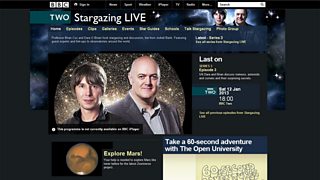
Stargazing LIVE
Stargazing LIVE is about so much more than watching telly. It's about giving people the info and encouragement they need to get involved with real astronomy. There are stacks of downloads, videos and other goodies on the Stargazing website including the which alone was downloaded 60,000 times in January.
Managing all the content on the website and liaising with the people who make it is a big part of my role. The analogy I use is that of the website as a shop where I’m the shopkeeper. Helped by colleagues I need to make sure everything is on the shelves and in the shop window in time for the grand opening - when and tell over three million viewers go to the site. Yikes.
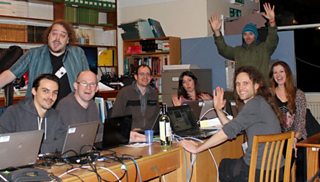
The web team and scientists during a live web chat at Jodrell Bank. I think I’m ‘reaching for the stars’
On location at I’m part of an experienced web team that includes Peter Harvey, Brett Tremble and Irene Kalkanis (all from Â鶹ԼÅÄ Learning) plus Alex Dackevych (Â鶹ԼÅÄ Factual). We share desks with the TV team in a makeshift production office. It’s hectic, cramped and cold but for those few days it feels like the centre of the Universe.
Before going on I should also thank the Â鶹ԼÅÄ , web developers, content producers and commissioning executives (bosses) who weren’t on location but did make it all happen.
Ìý
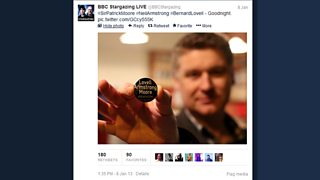
Our final tweet of the first night featured Jodrell Bank’s Tim O'Brien with a poignant message and was retweeted 180 times
So there’s all the stuff on the website but to make it a two-way conversation we use Twitter, Flickr, live web chats and online citizen science projects.
This year the time was ripe to run a Twitter account, , rather than flashing up an onscreen hashtag. More people are tweeting with each passing day and the TV team had a real appetite to make Stargazing more participatory than ever before.
By the way, at the Beeb we can’t open Twitter accounts willy nilly. First we speak to our social media experts who ensure that we’ve got the right experience and a long-term plan to offer relevant and fun content. As I run another Twitter account at the Â鶹ԼÅÄ it made sense that I'd kick things off for Stargazing before sharing duties with colleagues from Â鶹ԼÅÄ Learning. They’re still tweeting even though the programme is off air, so keep following.
And what did we use Twitter for? Well the account’s description (or ‘promise’ as I call it) at the time said 'news, event details and behind-the-scenes photos'. The wording was very deliberate. That’s all stuff I knew we could tweet quickly and easily. With little time to prepare it was a case of tweeting by your wits and being alert to photo opportunities. Oh and being nice to people – everyone likes a free badge.
One thing I didn’t want to do was invite loads of questions that we couldn’t fully answer on Twitter. The place for those was on , an extra programme that immediately follows the main show. It’s more relaxed and chatty, the perfect format for the presenters and guests to answer viewers’ questions.
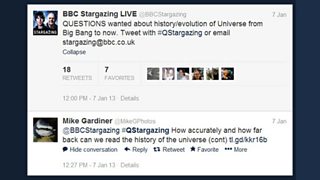
We asked our Twitter followers for their questions – a selection were answered in Stargazing: Back to Earth
So in the days or even minutes before each show we sent out tweets asking for astronomy questions. And so that the Back to Earth team could search for the questions in their Twitter feeds we asked people to include in their tweets.
I think we did pretty well on Twitter. Only one person manned the decks at a time but by the end of the series we’d tweeted over 700 times to 27,000 followers. Altogether there were more than 66,000 tweets made by people about the show. We even had a direct message from , an astronaut on board the (still boggles my mind).
Saying that, the fantastic response to the programme on Twitter meant it was hard to stay across it all. Indeed, trended worldwide for 15 minutes during the first episode. Next time (if they ask me back) I’d like to plan even more – though you still need to be spontaneous and react to unfolding events.
Ìý
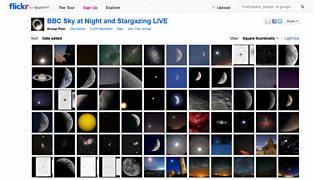
The Stagrazing LIVE and Sky at Night Flickr group
Right, I’ll quickly whizz through the other ways we grabbed the audience with our social tentacles, starting with .
Ever since Stargazing started in 2011 it’s shared a Flickr photo group with . I wasn’t involved back then but it was a smart move to tap into this existing and passionate astrophotography community and great to join up a revered Â鶹ԼÅÄ astronomy show with the new kid on the block.
Beyond the simple pleasure of sharing your starry snaps with others, there’s a further incentive: national fame! Each night on Back to Earth astronomer discusses his favourites. And it’s a handy resource for making extra online content too, such as this . As I write the Flickr photo group comprises almost 5,000 members and over 31,000 uploads.
Ìý
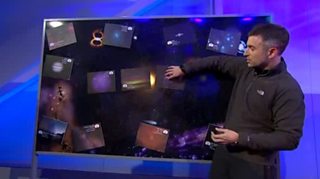
Astronomer Mark Thompson shows his favourite snaps from our Flickr photo group on live TV
Another way we spoke directly with the audience was through three with bona fide scientists. Each night several astronomers, including a in Houston, answered users’ questions as the show aired. We also used the chats to post pre-prepared behind-the-scenes photos, news and relevant facts.
There was an average of 3,350 users taking part each night and next year if we do them again I’d like Brian and Dara to shout from the rooftops that the chats also work on smartphones and tablets. And maybe we could look at doing them at different times - possibly earlier in the day when we could even coordinate with schools for a new and captive audience.
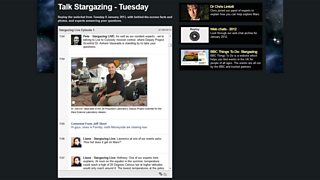
Live web chats
Finally, let’s explore Mars. Yes, really. Last year we teamed up with , the pioneering online citizen science group, and made quite a . After that success we wanted to offer something similar again and so was born. The gist is to help scientists understand more about the surface of Mars by getting the audience to spot particular features in .
My part was easy. I just had to speak to , the man behind Zooniverse, about when to put a big fat link on the Stargazing website. So far almost 70,000 participants have contributed to this real science by classifying over 3.6 million images. In most cases no human eye has ever seen these images before, I think that’s just brilliant.
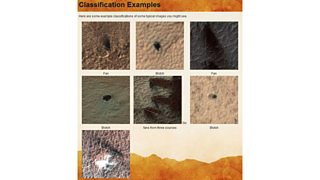
Planetary scientists need your help to understand the surface of Mars on Planet Four
I hope that gives you some insight into my role on Stargazing LIVE and how we use the web to interact with the audience at home. The Beeb’s mission is to inform, educate and entertain – hopefully we’ve added a little inspiration and discussion too.
Many thanks to the TV production team and our hosts at Jodrell Bank for yet again being so web-friendly.
Feel free to ask me anything in the comments below.
Simon Mackie is an assistant producer for Â鶹ԼÅÄ Factual.
